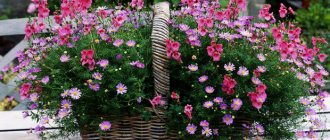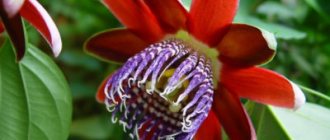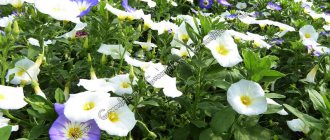Unlike Phalaenopsis or Dendrobium, orchids of the genus Tselogina are not so often found among lovers of home floriculture.
The reasons for its limited popularity can be very diverse, ranging from ignorance of the species, lack of space for growing, and ending with uncertainty when maintaining an exotic plant. Although this species of the orchid family is not particularly difficult to care for when grown in an ordinary city apartment and pleases the grower with elegant inflorescences of fairly large flowers of various shades and shapes.
Orchid Tselogina: description and care
Coelogyne is in most cases an epiphytic plant and only a small part of the species represents lithophytic varieties.
The species is considered one of the most numerous and has about 125-130 sympodial orchids. According to some reports, there are more than 200 of them.
The first appearances of this exotic beauty in Europe occurred in 1837. The botanical name refers to the shape of the flower, which has depressions on the stigma and comes from the Greek words koilos - depression, depression and gyne - woman.
Such a large number of varieties of Coelogina are united by sympodial growth, pseudobulbs having an oval, sometimes slightly angular shape and rounded hollow stems. Fragrant flowers with a diameter of up to 10 cm of varied colors are formed on the peduncles.
The difference is in the shape of the flower, which has 5 narrow petals and a fairly wide lower lip.
Homeland and territory of distribution in nature
Under natural conditions, it can be found over a fairly wide area: Southeast and Southern Asia, on islands located in the Pacific and Indian oceans. The mountain slopes of the Himalayas are considered their homeland.
Most common colors
The color range is very diverse, depending on the type - pure white, to delicate tones of green, yellow, cream, often with purple splashes.
There are many colors of Celogin.
Common varieties and popular varieties
Silver Carpet
Cotton Boll - instead of small flowers, the stem is crowned with a spikelet of round cotton bolls.
Cotton Ball
Big Ears, the name of this variety, fully justifies itself. The literal translation of the name is “big ears.” The leaves of this stachys have the shape of an elongated oval and reach a length of 250 mm.
Big Ears
Primrose Heron – golden bizantine. The soft fluffy leaves have a rich yellow-green color.
Primrose Heron
When choosing woolly stachys, it is advisable to consider the photos provided in order to have a more complete picture of it.
In addition to woolly varieties, many other varieties are found in nature. Some of them are even eaten. Chistets related, which is popularly called Chinese artichoke, has small spiral-shaped nodules on its rhizomes. They have a spicy taste and high nutritional value. In Brazil, varieties are grown that have edible leaves, they are fried in batter, blanched and used in the preparation of national dishes. There are also known medicinal varieties Stachys officinalis and Stachys sieboldii, which are successfully used in traditional medicine recipes.
Varieties of the Coelogina Orchid
Christata
One of the most popular when grown indoors is the Coelogina Cristata or Comb orchid. The place where this beauty grows is the Himalayas. It is distinguished by rounded bulbs with a pair of belt-shaped leaves.
On a peduncle growing up to 30 cm, there are from 3 to 10 buds , opening with flowers with a diameter of about 8 cm. The characteristic three-lobed lip is distinguished by an orange-yellow spot. Flowering begins in the first month of the year and lasts about one and a half months.
Christata.
Massanzha
A heat-loving resident of the Malay Archipelago with bulbs 10-12 cm long. The leaves are quite long, with noticeable venation. The flowering arrow reaches almost 60 cm, with numerous, from 15 to 20 cream-colored flowers.
The diameter of the flowers is about 5 cm. The sepals of the flower cover a wide lip. The lip is three-lobed, ocher-colored, with a yellow spot at the bottom. This orchid can bloom up to 3 times a year with several peduncles at once. Flowering time is May or June, lasting about two weeks.
Massanja.
Flacida or drooping
Compact orchid with elongated pseudobulbs and long drooping peduncle. Hence the name - Drooping. The leaves are bright green, lanceolate in shape, growing 2 pieces on each bulb.
About 9-15 fragrant flowers are formed on the flower stalk, with a diameter of 3-4 cm. The lip has 3 ridges and orange-yellow spots. Flowering period from December to May . The main peak occurs in March.
Flacida.
Pandurata
The leaves are folded, belt-shaped and 40-45 cm long, emerging from oblong bulbs up to 10 cm. The peduncle is cascading, forming about 10 large flowers , with creamy-green sepals.
Wide lip, with fringed ridges and prominent brown or black spots. Panduratha loves warmth and blooms in the summer, usually in June-July.
Panduratha.
Speciosa or lovely
A small, compact orchid with dense green growth. The leaves are short, oblong, light green in color. Flower-bearing arrows are also not impressive in height. They are short and form 1-2 buds in total.
The flowers are yellowish-green, about 6 cm in diameter, with a large and wide lip, on which there is a yellow spot with red-brown branches. Blooms almost all year round with an autumn peak.
Speciosa.
Types of coelogina, popular in indoor culture
The genus Coeloginus includes about two hundred species of sympodial orchids, differing in the number of flowers in the inflorescence, color range, size and arrangement of pseudobulbs. The most popular types of coelogines among collectors are:
| Species name | Characteristics of pseudobulbs and leaves | Number of flowers in inflorescence | Flower color |
| Comb or cristata (Coelogyne cristata) | Pseudobulbs are oval, up to 8 cm high, up to 4 cm in diameter. They have two small lower covering leaves of brown color and two apical, green, large, up to 30 cm in length, lanceolate-shaped. | 3-10 pieces, bloom at the same time | Snow-white, with a bright yellow lip base. |
| Pandurata (Coelogyne pandurata) | Pseudobulbs are flattened, elongated, 6-12 cm in height, 2-3 cm in diameter. They have small covering leaves and two large apical leaves, on noticeable petioles, belt-shaped, 20-50 cm long, green in color. | 5-12 pieces, bloom at the same time | Light green, the lip is strongly wavy with a black or brown pattern of strokes and veins. |
| Usita (Coelogyne usitana) | The pseudobulbs are elongated, 7 cm high, 2 cm in diameter. They bear one large apical leaf of light green color with noticeable veins. | Revolving type of flowering. They bloom one by one, one at a time, in a series of about 20 flowers. | Cream or slightly greenish, the lip is dark brown, almost black. |
| Beautiful (Coelogyne speciosa) | The pseudobulbs are oval, 6 cm high, 3 cm in diameter. They bear one apical leaf, lanceolate, on a long petiole, green in color. | Revolving type of flowering. They bloom in turn, in a series of up to 4 flowers. | Cream, the lip is white or greenish-cream with orange or bronze spots. |
Thus, different types of coelogines also differ in the type of flowering. Some of them bloom together, opening buds on the peduncle almost simultaneously. Others produce a series of several flowers that bloom one after another - after one flower stalk has faded, the next one releases from the apical bud.
The life cycle of coelogine is slightly different from other orchids and includes two dormant periods per year:
During the flowering period, adult celogina bushes are distinguished by their exceptional external showiness. The aroma of flowers varies from species to species. For example, the combed coelogyne (Coelogyne cristata) has a very weak odor, while the beautiful one (Coelogyne speciosa) has an intense, expressive aroma.
Reviews
Hope. “I took Christata from a friend. She didn't bother with the plant at all. I put the orchid in order, transplanted it into a new substrate, adding leaf humus to it. It is still acclimatizing, but I hope it will bloom soon, as its condition and development are good. Panduratha bloomed beautifully in the summer and is now on vacation.”
Eugene. “I generally like Tselogins. Especially their delicate aroma. I grow cristata and massanja. There are now 5 bulbs with peduncles on the massanja. Krista was a little sick because she was buried during the transplant. I had to replant it again, and since replanting is very difficult to tolerate, acclimatization takes a long time.”
Yana. “There is plenty of experience with growing phalaenopsis, but no experience with Tselogina. It turned out that everything is the same and even simpler. I bought a flowering cristata in the store and have had no problems with it for 5 years now. I replanted it once and immediately into a wider pot. Peculiar flowers, unusual for orchids at first glance, later on I like them even more. Plus a wonderful, delicate aroma when flowering.”
Transplantation of cellulum, containers and substrate
Active growth, constant expansion and increase in the size of the “family” of celogina, a large number of daughter plants require fairly frequent replanting. It should be carried out only as needed - when all the space in the pots is completely filled, but this process should not be delayed. During transplantation, it is preferable not to separate the families, especially if the maximum diameter of the containers has not been reached.
Transplanted coelogins. fedorchids
For celogina, the usual substrate for growing orchids is perfect - coarse, high-quality soil with an optimal ratio of bark, fern fibers, sphagnum and with the addition of coal. Coelogins love mulching, covering the substrate with sphagnum or decorative mosses to maintain stable humidity.
Coelogina fringed and beautiful are sometimes sold as epiphytes mounted on decorative and cork blocks, but any species feels much better in low but wide baskets and containers from among the typical containers for orchids with holes for free air circulation.
The plant is carefully handled, the old soil is removed only if there are signs of fungal disease. It is advisable to place drainage and large heavy stones at the bottom of the container, which increase the stability of the orchid. If the old container is heavily entwined with roots, it is better to plant the entire orchid in a new container along with the old basket.
Botanical characteristics
Epiphytic and lithophytic varieties
Most species of Coelogina are epiphytes that grow on trees. There are not many lithophytic varieties, but there are species that are both epiphytes and can grow on rocks or stones. Very few terrestrial species are found.
The most famous epiphytes of Tselogin:
- broadwing (Coelogyne brachyptera);
- comb (Coelogyne cristata);
- fringed (Coelogyne fimbriata);
- drooping (Coelogyne flaccida);
- browning (Coelogyne fuscescens);
- Lawrence (Coelogyne lawrenceana);
- speckled (Coelogyne lentiginosa);
- Massange (Coelogyne massangeana);
- Moorea (Coelogyne mooreana);
- veined (Coelogyne nervosa);
- most aromatic (Coelogyne odoratissima);
- Schiller (Coelogyne schilleriana) and many others.
Coelogyne schilleriana.
Epiphytes, which can also be lithophytes:
- shield (Coelogyne corymbosa);
- graceful (Coelogyne speciosa);
- Swanna (Coelogyne swaniana);
- felt (Coelogyne tomentosa);
- three-veined (Coelogyne trinervis);
- Coelogyne usitana;
- lovely (Coelogyne venusta) and others.
Photo of Coelogina scute.
Plant structure
The genus Coelogina is so numerous and varied in size and shape.
A common feature for all is sympodial growth - a type of branching with horizontally growing shoots called pseudobulbs, which are interconnected by a rhizome (rhizome).
The structure is standard for orchids - stem, leaves, roots, peduncles.
Mature plant height
Depending on the type, the height can be from 15 to 30 cm . Pseudobulbs, thickened aboveground or aerial roots, also vary significantly in height, from 3 to 12 cm.
Number of leaves
The leaf shape is either elongated-oval or lanceolate-belt-shaped, with a sharp tip. In some species, veining is noticeable on the inside.
The color of the leaves is rich, from bright green to dark emerald.
The length can reach up to 25-30 cm , with a leaf blade width of up to 5 cm. The number of leaves originating in each group of pseudobulbs is from 1 to 3.
Maximum peduncle length
Before the winter period, drooping peduncles usually form from the base of the pseudobulbs. The length is directly dependent on the type of Celogin and varies from 20 to 60 cm.
Diameter, flower shape
It is the shape of the flower, reminiscent of a butterfly, a lady's slipper, or a bumblebee located on a flower, that arouses such interest among flower growers. Each flower has 5 narrow, lanceolate, splayed sepals.
In the center of the flower there is a three-lobed, narrow lip . Its side lobes are colored orange or red. And at the base you can see several protruding comb-like growths.
The diameter of flowers, depending on the type, can be up to 10 cm.
Coelogina flower.
Important! Almost all varieties of Celogina have a delicate and unsweetening aroma.
What does celogina look like?
Despite their abundant flowering, coelogins could never compete in popularity not only with phalaenopsis and dendrobiums, but also with vandas or cattleyas.
This is not the most common, but definitely a special plant of the Orchid family; it differs pleasantly from its indoor competitors in both its unpretentiousness and the duration of flowering. But the main “trump card” of coelogin is the number of flowers. Growing rapidly and pleasantly surprising with blooming clouds, this orchid certainly claims to be one of the most graceful soloists.
Among gardeners, coelogines are also known as “bride orchids”, “white fairies”, “snow cloud”, and Hololeika. This orchid is easy to distinguish against the background of phalaenopsis and other indoor orchids by its drooping peduncles and numerous snow-white flowers.
Coelogines are sympodial orchids with short roots, whose elongated pseudobulbs are surprising in their round shape and compact size (on average up to 5 cm in length). They produce only a couple of sessile leaves.
Coelogines cannot compete with the more popular orchids in terms of showiness and size, but due to the fact that plants are never grown one at a time and create colonies, the greenery of coelogines makes a vivid impression, and the plant itself looks impressive. Linear, with a prominent fold, glossy, dark green leaves of celogina look elegant even when the plants are not blooming. The leaves do not exceed 30 cm in length.
The flowering of celogina is one of the most luxuriant among indoor orchids. Peduncles grow from the base of the pseudobulbs, powerful and strong, they are crowned with a brush of inflorescence consisting of 5-7 pedicels and buds. After blooming, the flowers grow up to 9 cm in diameter, their rare arrangement allows you to appreciate the beauty of each individual flower, but at the same time, the plant seems to be covered with a huge continuous cloud of flowers.
Each pseudobulb produces only one peduncle, but the whole family of coelogines produces an astonishing number of peduncles at the same time, and the number of simultaneously blooming flowers is measured in the dozens. Long, sparse drooping brushes are very beautiful.
The structure of the coelogina flower is very elegant. The lower three-lobed lip, pointed petals, original waviness and outgrowths similar to small “brushes” - everything in this orchid evokes thoughts of tenderness.
Coelogina orchid. Eerika Schulz
The color scheme of coelogines is quite boring, if one can say so about the impeccable snow-white color of most coelogines. Snow-white, shining, as if glowing, thanks to the texture of the petals, the color is only emphasized by the yellowish-orange outgrowths and “colored” details on the lip. Less common are cream and yellow-green species. Cologins also pleasantly surprise with their delicate aroma.
The flowering period of celogina adorns the first half of the calendar year. Traditionally, this orchid blooms only in the middle of winter and offers you to enjoy the beauty of its white inflorescences until the first spring stars come into their own.
Flowering of the celogina from January to April is typical, but often the orchid pleases at completely different times, sometimes from March or April to mid-summer. It all depends on the conditions and habits of the plant itself: how the cycle was built in the flower center, and how the temperatures and lighting in a particular house change as the seasons change.
Life cycle stages
The appearance of greenery, new pseudobulbs, the formation of shoots
In spring, at the beginning or middle of April, up to 2 sharp vegetative shoots form at the base of the bulbs. The sprouts, reminiscent of yellow ears, develop quite quickly, forming a juicy green mass by summer.
The shoots take nutrition from old bulbs, which gradually shrink and lose their barrel-shaped shape . In mid-summer, at the base of the leaf mass, new pseudobulbs can be seen, reaching 5 cm or more in height.
Over time, they grow their own rhizomes and begin to feed on their own. And the old ones are regaining their shape, gaining strength and energy.
Root formation
Young roots are formed together with the formation of new pseudobulbs. And they stop growing when they ripen. If other types of orchids are not watered after flowering, then Tselogina needs watering, as its roots grow.
Period of active vegetation and dormancy
Active growth of the orchid occurs almost throughout the summer period and covers a small part of autumn . As temperatures drop and daylight hours shorten, in late September - early October, the plant enters a stage of relative dormancy. It is after this that it enters the flowering stage.
During this period, the plant must be provided with cool and dry climatic conditions. At this moment, new flower sprouts are formed at the base of the pseudobulbs, which already have formed buds in December. Then the orchid blooms until March and again enters a short resting stage lasting 15-20 days.
Peculiarities
The indoor flower pachistachis belongs to the Acanthaceae family, which are dicotyledonous plants and grow in tropical rain forests. This fast-growing shrub is capable of reaching a height of 60 centimeters to a meter. The stem of an adult evergreen pachystachys is tree-like, the leaf blade grows to 13 centimeters in size and has the shape of a pointed elongated oval. The color of the leaves is a rich dark green; multiple veins are clearly visible on the leaf, giving the impression of texture.
Flowering in Pachistachis begins in early spring and continues continuously until late autumn. The yellow inflorescence of a spike-shaped structure reaches 15 cm in size, it is erect and develops only at the ends of the shoots. The inflorescence contains small white flowers - they can be up to 5 centimeters long, but fall off very quickly, so the main decorative attractiveness of the flower lies precisely in the yellow spike-shaped bracts, which delight the eye for quite a long time. The key to abundant flowering of a perennial is good lighting and sufficient watering. On hot days, pachistachis should be sprayed. When exposed to direct sunlight, the plant may wilt, but if it is moved to the shade in time and watered thoroughly, it will come back to life.
Main features of flowering
Period and duration
For each species of this type of orchid, the flowering process is different and can be extended differently. Flowering occurs in summer and autumn-winter. It all depends on the variety. average duration This refers to the duration of flowering of one flower-bearing arrow. And there can be several of them and in some species they can bloom almost all year round.
Coelogina can produce several flower stalks at once.
Stimulation
The process and methods of stimulation do not differ from the classic ones for orchids. First of all, this means lowering the temperature to 12-15° C. This temperature stimulates the plant well for a couple of weeks, plus reducing watering.
But usually in apartments it is almost impossible to achieve such a reduction. Then you just have to wait until the orchid deigns to bloom.
Important! A young plant should not be stimulated by allowing it to gain leaf and root mass in order to respond with full flowering.
Maintenance and care at home
Optimal plant conditions
Creating conditions and care do not require much effort from the grower, but certain recommendations for the full development of the plant should be followed. The most important ones include maintaining:
- humidity. The humidity level for Tselogina should be constantly high - 70-85%. Such humidity is ensured in an apartment by placing the plant in a tray (possibly with ground peat) with water. You should especially monitor the humidity level in the hot season;
- temperature conditions. Depending on the temperature, the varieties of this orchid are divided into three groups: those that prefer hot or relatively hot - from 20 to 30 ° C, with a difference between night and day temperatures of about 2-3 °;
- well-tolerant of cool temperatures from 15 to 20° C, with a difference of 5-7°;
- cold-loving, fully developing at temperatures from 15 to 20 ° C and a temperature difference of up to 10 °.
Watering and fertilizing
For Tselogina, which prefers hot temperatures, the substrate should be moist throughout the year. Other groups need such a substrate from spring to autumn.
During the hot season, watering is carried out daily, using the immersion method , until the substrate is completely saturated with moisture. The remaining moisture should be allowed to drain and only then the orchid should be placed in its permanent place.
In winter , when new pseudobulbs gain the size of old ones, you need to give the substrate time to dry between waterings. Orchids that prefer hot temperatures do not need this.
Tselogina is very sensitive to water quality. The water should be soft, neutral acidity, settled and filtered. It is better to use rain or melt water for irrigation.
Use rain or melt water for irrigation.
Fertilizing is carried out only with special fertilizers for orchids . During the growth period of pseudobulbs, which occurs after flowering, additional nutrition should be added at every second watering according to the attached instructions for the fertilizer.
Experienced gardeners even recommend reducing the concentration of fertilizing by 2-4 times. During the dormant period, fertilizing is excluded.
After flowering and during the dormant period
One of the characteristics of the Coelogina orchid is that its different species have different dormant periods . For some, it practically does not exist at all. Therefore, some species can bloom almost all year round.
This type of orchid does not require molding pruning . Faded flower stalks can be trimmed immediately after flowering.
Watering does not stop completely, since after flowering a period of root growth begins.
This also applies to nutrition. For those species that actually enter the dormant stage, watering is significantly reduced and fertilizing is eliminated.
Advice! The florist must become familiar with the characteristics and biological life cycle of each variety so as not to harm the plant.
Prevention of diseases and pests
The main danger to the plant can be pests (spider mites, aphids, whiteflies) and fungal diseases. Prevention consists of proper care and timely treatment with drugs in case of parasites.
Therefore, after purchasing, you need to carefully examine the plant and, if necessary, treat it with appropriate preparations.
Throughout the entire life cycle, change the soil in a timely manner and monitor the condition of the foliage and root system.
Possible problems when growing tselogina
When growing tselogin, you are likely to encounter the following problems:
- Decay of young pseudobulbs. The reason is waterlogging of the substrate or water entering the growing point. It is difficult to correct the situation; most often the damaged growth has to be removed.
- Rotting of the base of mature pseudobulbs. The reason is waterlogging, contact with wet moss, deep planting. The plant needs to be transplanted into a less moisture-intensive substrate, the rotten parts of the pseudobulbs must be cut out, treating the sections with a systemic fungicide.
- Root and rhizome rotting. The reason is waterlogging of the substrate, watering at low air temperatures or during the dormant period. The plant requires emergency replanting with soil replacement, pruning of damaged roots, and treatment with a systemic fungicide. If the orchid has completely lost its roots, resuscitation measures are indicated to restore the root system.
- Dry brown or black spots on the leaves, loss of turgor, wrinkled pseudobulbs. The reason is sunburn, exposure to dry air at elevated temperatures. Correction of conditions of detention is necessary.
Sometimes flower growers may experience failure of the plant to bloom. There can be many reasons for this phenomenon. Most often the problem is a violation of the temperature regime or lack of lighting.
Planting and transplanting
Soil selection
For orchids, there are many varieties of soil on sale, which is commonly called substrate. For beginners who decide to grow such exotic plants, it is better to use ready-made substrate kits. The main thing is that the soil is intended specifically for epiphytic species.
More experienced home gardeners prefer to prepare the soil themselves. The difficulty lies in the correct selection of components, their quality and quantitative arrangement.
You can prepare the orchid substrate yourself.
The optimal composition of such a substrate includes:
- well-calcined pine bark of the required fraction;
- charcoal;
- decomposed leaf compost;
- sphagnum moss;
- inert materials: perlite, vermiculite, expanded clay or foam.
Important! The main condition for the substrate is at least 50-60% bark content.
Optimal capacity
Depending on the type, the appropriate container is selected. For varieties with large and long roots, it is better to use pine bark blocks.
For others, the best option would be wide and short flower pots with the required number of drainage holes.
It is quite common to plant Celogin in various plastic baskets and containers with a large number of slits and holes.
Technology
The transplant is not particularly difficult. Accuracy and high-quality selection of substrate are the main conditions:
- The transplanted orchid is cleaned of the old substrate, damaged and rotten roots are cut off;
- Treat the cut areas with activated carbon powder and allow to dry;
- Drainage made of inert materials is placed in a new container and the root part is lowered into it and the space is filled with substrate, compacting it slightly. The rhizome is covered with moss;
- For tall plants, it is advisable to place a counterweight at the bottom so that the plant does not fall over.
Planting celogina: pots and substrates
Coelogines are epiphytic orchids and can theoretically be grown on blocks or in hanging baskets. But in amateur practice, this method of growing is not found, since indoor conditions usually do not have enough air humidity and the blocks and baskets dry out too quickly. Therefore, pot planting is more appropriate.
For colognes, wide but not very deep containers are usually chosen, which allow the plants to grow in breadth. These orchids do not take well to transplantation; they take a long time to adapt, often stopping flowering for the next couple of seasons. Based on this, pots are selected with a small margin in diameter so that the cellulite can not be subjected to stress for 3 years.
A substrate suitable for celogina can be composed of different components:
| Substrate option | Fine pine bark (0.5 cm) | Long stem sphagnum | Fern roots | Coconut fiber | Charcoal | Rotten oak leaves |
| №1 | 3 parts | 1 part | – | – | 1 part | 1 part |
| №2 | 2 parts | – | 1 part | – | 1 part | – |
| №3 | 2 parts | ½ part | – | ½ part | – | 1 part |
At the bottom of the pot it is necessary to place a good drainage layer consisting of expanded clay, pieces of broken brick or polystyrene foam.
The frequency of watering the plant depends on the moisture capacity of the substrate. When growing on quick-drying soil, you can lay a layer of sphagnum on its surface, which will prevent too much moisture evaporation. But in this case, watering should be as careful as possible, and the moss itself should not touch the pseudobulbs
Reproduction methods
By dividing the rhizome
Propagation is carried out by dividing the rhizomes. For a sufficiently mature orchid, the rhizome is cut so that each section contains at least 3-4 young and old pseudobulbs. The cut areas are processed and dried. Then they are planted in moss and secured well (preferably with wire).
After the roots appear, the frequency of watering increases. Some gardeners plant them directly in prepared soil. Newly appeared orchids usually bloom 2-3 years after division.
Propagation by division of rhizomes.
How to care for a plant
- Illumination
The flower needs bright light throughout the year. It will develop best on windows located on the east or west side. The north side is too dark for a plant of this type, and if you place it on the south, you will have to shade it from the sun.
Throughout the year, the duration of daylight hours should be from 12 to 15 hours. Therefore, in winter they organize additional lighting.
- Temperature
When providing care for the celogina orchid at home, you need to maintain a suitable temperature, which depends on what type of plant it is. In summer, almost any species will grow normally at 21-24°C.
In winter, the temperature should not be below 10°C. But the coelogina comb is more cold-loving. Therefore, it can be kept in winter at a temperature not lower than 5°C.
- Rest period
It is expressed only in some species. For example, the beautiful Coelogina does not have such a period, and can bloom at any time. There is no such period in the species Coelogina fringed. But it blooms only at a certain moment.
At the end of spring, the species Coelogina crested has a period of rest for several weeks. At this time, the root system stops growing somewhat, and the pseudobulbs shrink.
- Watering the plant
The flower is watered by immersing the flower pot in a container of water for 2-3 minutes. There should be only soft water in the container. Therefore, before the procedure it must be filtered or boiled. Otherwise, a white coating will appear on the surface of the plant. When the dormant period begins, watering is reduced.
- Air humidity
Care for celogina orchids involves maintaining high humidity. To ensure such conditions, water is poured into the pan and expanded clay is poured into it. The leaves are sprayed daily in the morning and evening.
- Soil mixture
To plant such a flower, a ready-made mixture from the store, specially prepared for growing orchids, will be a suitable option. A fine-grained substrate with pieces of pine bark and leaf compost is used.
Orchids, which have long roots, are grown on blocks of pine bark. For example, coelogina fringed. The roots are secured to the surface with wire, and sphagnum is laid on top. This type of cultivation requires frequent watering.
- Fertilizer
When the flower is actively growing, you need to fertilize the substrate weekly. Foliar feeding is also carried out. Fertilizer is applied specially, which is designed for orchids. During flowering, fertilizer is applied monthly.
Previously, we talked in detail about the proper care of orchids.
Orchid transplant
The Tselogina orchid is transplanted only if it is necessary. For example, the roots become very crowded in the pot.
If the bush is large, then when replanting, you need to place a heavy object at the bottom of the container to protect the pot from tipping over under the weight of the orchid. This can be large pebbles or pieces of granite.
Plant propagation
When grown at home, coelogina is propagated by division. Take an adult orchid that has several pseudobulbs. Each part should have several young and several old pseudobulbs. They must have developed roots.
Diseases, pests
Spider mites are most commonly seen on leaves . If it is detected, the flower is washed very thoroughly under warm water. In the same way they fight whiteflies or aphids. Often the flower is affected by a fungus, which must be gotten rid of immediately after detection of the disease using fungicides.
Common diseases, their treatment and prevention
Spider mite
The use of chemicals is not recommended or should be used with great caution.
The best option for spider mites is to place the orchid under a warm shower and then wipe all areas of the plant.
Fungal infections
Fungal diseases appear mainly due to inadequate care or inappropriate conditions. If an infection is detected, fungicidal drugs are used.
Diseases and pests
Spider mites often live in the leaf axils. As soon as the first signs of infection are detected, the flower is washed under running warm water, paying special attention to the leaf blades. In addition to mites, the ground parts of the orchid attract aphids and whiteflies. These pests are removed using an identical method. Sick specimens are temporarily isolated from neighbors until they recover.
To save the plant from fungal diseases, they are treated with fungicidal drugs. However, you need to start treatment procedures as early as possible.
Orchids CELOGYNA











